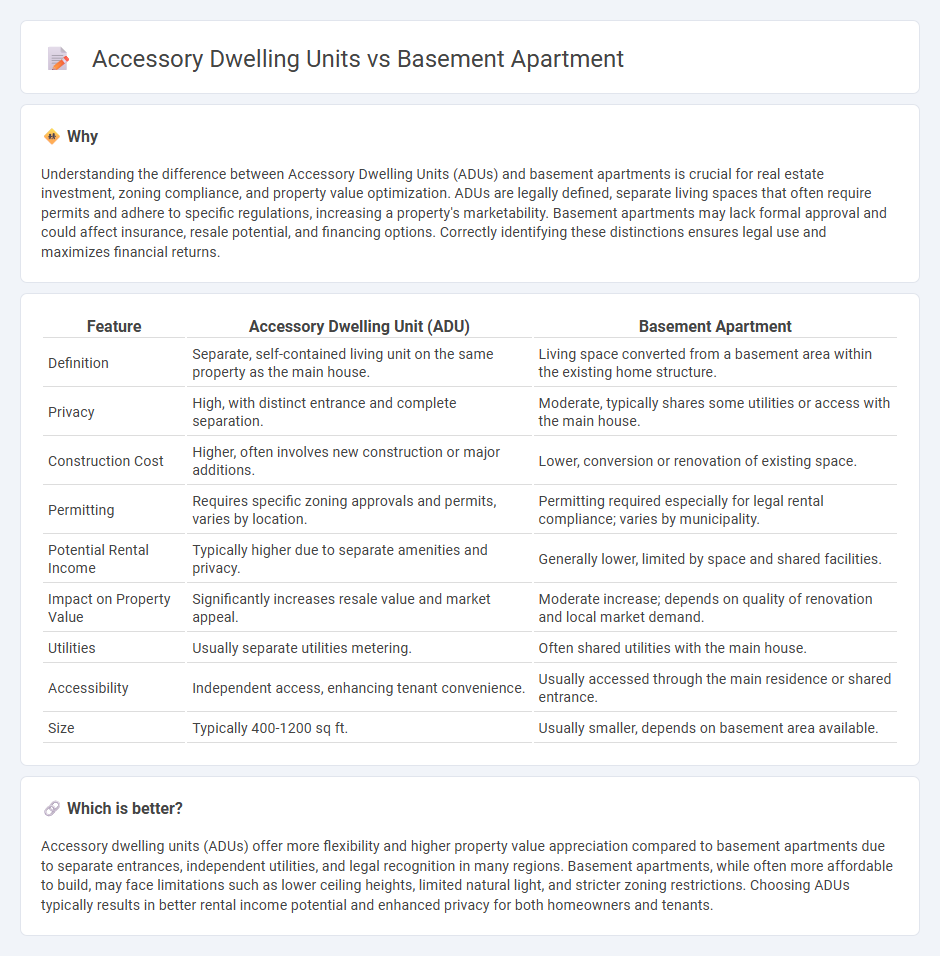
Accessory dwelling units (ADUs) are self-contained living spaces added to a property, often featuring separate entrances, kitchens, and bathrooms, enhancing property value and rental income. Basement apartments, typically located below the main living area, provide cost-effective housing options but may have limitations in natural light and egress requirements. Explore the benefits and regulations of both to determine the best investment for your real estate goals.
Why it is important
Understanding the difference between Accessory Dwelling Units (ADUs) and basement apartments is crucial for real estate investment, zoning compliance, and property value optimization. ADUs are legally defined, separate living spaces that often require permits and adhere to specific regulations, increasing a property's marketability. Basement apartments may lack formal approval and could affect insurance, resale potential, and financing options. Correctly identifying these distinctions ensures legal use and maximizes financial returns.
Comparison Table
| Feature | Accessory Dwelling Unit (ADU) | Basement Apartment |
|---|---|---|
| Definition | Separate, self-contained living unit on the same property as the main house. | Living space converted from a basement area within the existing home structure. |
| Privacy | High, with distinct entrance and complete separation. | Moderate, typically shares some utilities or access with the main house. |
| Construction Cost | Higher, often involves new construction or major additions. | Lower, conversion or renovation of existing space. |
| Permitting | Requires specific zoning approvals and permits, varies by location. | Permitting required especially for legal rental compliance; varies by municipality. |
| Potential Rental Income | Typically higher due to separate amenities and privacy. | Generally lower, limited by space and shared facilities. |
| Impact on Property Value | Significantly increases resale value and market appeal. | Moderate increase; depends on quality of renovation and local market demand. |
| Utilities | Usually separate utilities metering. | Often shared utilities with the main house. |
| Accessibility | Independent access, enhancing tenant convenience. | Usually accessed through the main residence or shared entrance. |
| Size | Typically 400-1200 sq ft. | Usually smaller, depends on basement area available. |
Which is better?
Accessory dwelling units (ADUs) offer more flexibility and higher property value appreciation compared to basement apartments due to separate entrances, independent utilities, and legal recognition in many regions. Basement apartments, while often more affordable to build, may face limitations such as lower ceiling heights, limited natural light, and stricter zoning restrictions. Choosing ADUs typically results in better rental income potential and enhanced privacy for both homeowners and tenants.
Connection
Accessory dwelling units (ADUs) and basement apartments both serve as supplementary living spaces within a primary residential property, enhancing housing density and affordability. ADUs can be detached or attached structures, while basement apartments are specifically converted underground spaces, often benefiting from separate entrances and utilities. Both options leverage existing property to generate rental income and address urban housing shortages efficiently.
Key Terms
Zoning regulations
Basement apartments and accessory dwelling units (ADUs) are subject to distinct zoning regulations that vary significantly by municipality, impacting aspects such as minimum unit size, parking requirements, and occupancy limits. While basement apartments often face stricter restrictions due to fire safety codes and egress requirements, ADUs may benefit from more lenient zoning provisions aimed at encouraging affordable housing development. Explore local zoning ordinances to understand specific regulations and opportunities for creating legal, compliant secondary living spaces.
Egress requirements
Basement apartments must comply with strict egress requirements, including at least one emergency escape and rescue opening that meets minimum size and operational standards to ensure occupant safety. Accessory dwelling units (ADUs) may have more flexible egress criteria depending on local building codes, often allowing alternative exits if they meet safety and accessibility regulations. Learn more about the specific egress codes for basement apartments and ADUs to ensure your property meets legal safety standards.
Separate utilities
Basement apartments typically share utilities with the primary residence, which can complicate billing and maintenance. Accessory dwelling units (ADUs) are designed with separate utility connections, allowing for independent metering of water, electricity, and gas, enhancing privacy and cost management. Explore more about how separate utilities impact energy efficiency and legal considerations in ADUs vs basement apartments.
Source and External Links
What You Should Consider Before Moving Into a Basement Apartment - This article explores the opportunities and challenges of living in a basement apartment, including lower rent and potential space constraints.
What is a Basement Apartment? - This post discusses the characteristics and considerations of basement apartments, including affordability, privacy, and potential risks like flooding.
Basement Apartment Living: The Ultimate Guide - This guide provides an overview of basement apartment living, covering benefits like reduced utility costs and challenges such as limited natural light.
 dowidth.com
dowidth.com